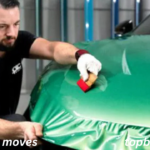When it comes to repairing damaged surfaces, few products are as versatile and effective as Bondo. This brand has become synonymous with auto body repairs, home fixes, and even artistic endeavors. Whether you’re a DIY enthusiast or a professional, understanding the ins and outs of Bondo can help you achieve smooth, durable repairs every time. This comprehensive guide will walk you through the different types of Bondo, how to use it, common applications, and pro tips for getting the best results.
What is Bondo?
Definition and Origins of Bondo
Bondo is a brand of body filler that has been a staple in the automotive and home repair industries for decades. Originally developed in the 1950s by a company called the Bondo Corporation (now part of 3M), this product was first used in the auto industry for repairing dents and rust. Its quick-drying formula, combined with a hardening compound, made it an instant hit with car mechanics and DIY enthusiasts. Over time, Bondo expanded beyond automotive uses and is now popular in a range of applications, from home repairs to artistic projects.
The core appeal of Bondo lies in its ability to bond with various surfaces, filling gaps and creating a smooth, sturdy finish. Thanks to its versatility, Bondo is widely recognized as a go-to solution for anyone looking to restore or repair a damaged surface without replacing the entire material. Today, there are many variations of Bondo designed for specific applications, making it even more adaptable for different types of repair projects.
Components and Composition of Bondo

Bondo’s effectiveness stems from its carefully formulated composition. The main components of Bondo are the resin and the hardener. The resin is a polyester-based compound that serves as the base of the filler, providing structure and durability. When mixed with the hardener (a catalyst), a chemical reaction occurs, causing the mixture to set and harden. The filler part of Bondo consists of fine powders or fibers that enhance the strength and texture of the product, allowing it to fill holes and imperfections effectively.
The quality and type of filler vary depending on the specific Bondo product. For example, Bondo for automotive repairs may contain fiberglass strands for added durability, while Bondo designed for woodworking might include finer powders for a smoother finish. This flexibility makes Bondo suitable for use on a wide range of materials, including metal, wood, fiberglass, and plastic.
Different Types of Bondo
Bondo is not a one-size-fits-all solution. There are several different types of Bondo products available, each designed for specific repair needs. The most common varieties include:
- Standard Bondo Body Filler: This is the classic version, ideal for repairing dents, rust holes, and scratches on automotive bodies.
- Bondo Fiberglass Resin: Specifically formulated for use on fiberglass surfaces, this type is often used for boat hull repairs and other applications requiring water resistance.
- Bondo Plastic Body Filler: This product is designed for use on plastic parts, offering a flexible yet durable solution for repairing automotive bumpers or plastic fixtures.
- Bondo Glazing and Spot Putty: A thinner, finer product used to fill small imperfections like pinholes or minor scratches before painting.
Each type is optimized for different materials, making it crucial to select the right Bondo for your project to ensure optimal results.
How to Use Bondo: Step-by-Step Guide
Preparation Before Applying Bondo
Before you begin using Bondo, proper surface preparation is key to achieving a flawless finish. Start by cleaning the damaged area thoroughly to remove dirt, grease, or old paint. This ensures that the Bondo will bond properly with the surface. Use sandpaper to roughen the area slightly, which helps the filler adhere better.
Once the surface is clean and prepped, it’s time to mix your Bondo. Typically, Bondo comes with a resin and hardener that must be mixed together in the correct proportions. The instructions will specify the ratio, which is crucial for ensuring proper curing. A common mistake when using Bondo is incorrect mixing, which can lead to the product not hardening properly or setting too quickly.
Application Process
After mixing the Bondo, apply it generously to the damaged area using a spreader or spatula. Work the Bondo into the hole or crack, pressing it firmly to eliminate air bubbles and ensure a strong bond. Depending on the size of the damage, you may need to apply multiple layers of Bondo. Each layer should be smooth and level, and you should allow it to cure before adding more layers.
While applying, take care to shape the Bondo to match the contours of the surface. For example, if you’re working on a car door, ensure the filler follows the natural curve of the panel. Don’t worry if the application is a bit uneven at first—Bondo is easy to sand down once it’s fully cured.
Drying and Curing Time
One of the most important steps when using Bondo is allowing it to cure completely. Curing time can vary depending on the temperature and humidity, but most Bondo products will set in about 20-30 minutes. However, full curing can take several hours. It’s important to let the filler fully harden before sanding or painting, as this will give you the smoothest, most durable finish.
To test if the Bondo is fully cured, lightly press your finger on the surface. If it feels firm and doesn’t leave an indentation, it’s ready for sanding. Always follow the manufacturer’s instructions for curing times to avoid ruining your work.
Common Uses of Bondo
Automotive Repair
Bondo’s primary use has always been in the automotive industry. It’s the go-to solution for fixing dents, cracks, and rust spots on car bodies. When applied correctly, Bondo can restore the appearance and structural integrity of vehicles without the need for expensive body panels or professional repairs.
For automotive repairs, Bondo is often used in combination with fiberglass mats for added strength. This is especially useful for larger, more structural repairs such as fixing rust holes in the floorboards or on the underside of the vehicle. Automotive Bondo can be easily shaped and sanded to match the original contours of the vehicle, making it almost impossible to tell the difference between the repair and the surrounding area once painted.
Marine Applications
Bondo isn’t just for cars—it’s also a fantastic product for marine repairs. The Bondo Fiberglass Resin, in particular, is designed to withstand the harsh marine environment, making it ideal for fixing boats, jet skis, and other watercraft. Whether you’re dealing with a cracked hull or a damaged fiberglass deck, Bondo offers a waterproof, durable solution.
When using Bondo for marine applications, it’s essential to ensure that the product is properly mixed and applied to a clean, dry surface. Bondo’s water-resistant properties make it perfect for repairs below the waterline, offering long-lasting results that can stand up to the demands of the marine environment.
Home and Furniture Repairs
Bondo’s versatility extends beyond vehicles and boats—it’s also great for home and furniture repairs. It can be used to fix damaged drywall, wood furniture, or even restore chipped ceramic items. For instance, if a wooden table has a deep gouge or your drywall has a large hole, Bondo can fill the damage and provide a smooth surface for painting or refinishing.
Additionally, Bondo’s ability to bond to different materials makes it useful for creative projects. Whether you’re repairing old furniture or fixing holes in walls, Bondo ensures that your repairs are strong, smooth, and visually seamless.
Tips and Troubleshooting for Working with Bondo
Common Mistakes and How to Avoid Them
Using Bondo can be tricky if you’re not familiar with the process. Common mistakes include mixing the resin and hardener incorrectly, which can prevent proper curing. Always follow the ratio indicated on the packaging and mix thoroughly to ensure a consistent blend. Another mistake is applying Bondo too thickly, which can cause uneven curing and longer drying times.
To avoid these mistakes, ensure your workspace is well-prepared, use the correct tools, and give yourself ample time to complete the job properly.
Tools You’ll Need
For best results, you’ll need a few basic tools: a mixing container, a spreader or spatula for applying the Bondo, sandpaper (medium and fine grit), and safety gear like gloves and a dust mask. If you’re working on a larger area, an electric sander can make the job easier and faster.
Enhancing the Finish
After applying Bondo and allowing it to cure, you’ll need to sand it down to achieve a smooth, even finish. Start with medium-grit sandpaper to remove any excess material, then follow up with finer grits for a polished surface. After sanding, you can apply a primer or paint to match the surrounding area. For the best results, consider using a clear coat or sealer to protect your repair from the elements.
Conclusion
Bondo is an indispensable tool for anyone who enjoys DIY repairs, whether you’re fixing your car, boat, home, or furniture. With its quick-drying, durable composition, Bondo offers a reliable solution for a wide range of repair needs. By understanding the different types of Bondo and following the proper techniques, you can achieve smooth, professional-quality results every time.
FAQs
What is the difference between Bondo body filler and Bondo fiberglass resin?
Bondo body filler is designed for general repairs, while fiberglass resin is specially formulated for use on fiberglass surfaces, such as boat hulls.
Can Bondo be used on metal surfaces?
Yes, Bondo works well on metal surfaces, including car bodies, and is often used for rust repairs.
How long does Bondo take to cure completely?
Bondo typically sets in 20-30 minutes, but full curing can take several hours.
Is Bondo waterproof for marine applications?
Yes, Bondo’s fiberglass resin is water-resistant, making it ideal for use in marine environments.
Can I paint over Bondo after it has cured?
Yes, Bondo can be sanded smooth and painted over once it has fully cured.
You May Also Read: https://topbuzusa.com/ufc-illegal-moves/





